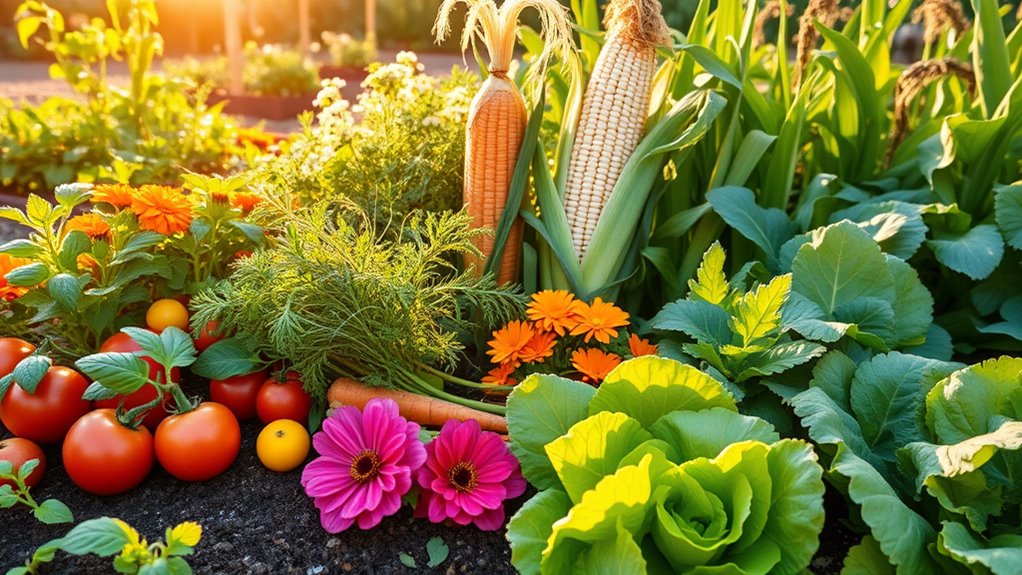5 Companion Planting Secrets That Boost Your Harvest
You’ll boost your harvest with these 5 evidence-based companion planting secrets. Pair marigolds with tomatoes to naturally repel pests like nematodes, as studies confirm, cutting chemical use. Grow beans alongside heavy feeders to fix nitrogen and enrich soil nutrients for healthier plants. Interplant fast-maturing radishes with carrots to maximize space and achieve up to 50% higher yields. Attract beneficial insects such as bees and ladybugs using sunflowers and herbs for better pollination and pest control. Avoid common conflicts like planting beans near onions to prevent growth issues, and uncover how these strategies transform your garden.
Pairing Plants for Natural Pest Control
When you’re planning your garden, pairing plants for natural pest control can dramatically reduce chemical use by leveraging their natural defenses.
For effective companion planting tips, you pair marigolds with tomatoes to repel nematodes, as research confirms.
Plant basil near peppers to ward off aphids, and interplant onions with carrots to confuse pests, all backed by evidence-based studies. Additionally, companion plants like borage can enhance tomato growth and flavor by providing essential nutrients.
Boosting Soil Nutrients With Companion Crops
While you’ve explored pairing plants for pest control, consider how companion crops can naturally enrich your soil’s nutrients.
For instance, planting nitrogen-fixing legumes like beans alongside heavy feeders boosts available nitrogen, as studies show they convert atmospheric nitrogen into soil forms.
You’ll enhance microbial activity too; mix in cover crops such as clover, which research confirms adds organic matter, improving fertility for better yields. Additionally, incorporating companion planting benefits can lead to healthier plants and increased biodiversity in your garden.
Maximizing Space Through Interplanting Techniques
How can you squeeze more from your limited garden space?
Interplanting lets you grow multiple crops together by pairing fast-maturing ones with slower varieties, like radishes alongside carrots.
This technique maximizes light and soil use, as evidenced by studies from agricultural extensions showing up to 50% higher yields.
You’ll efficiently boost production without expanding your plot. Additionally, using companion planting combinations can further enhance pest deterrence and overall plant health.
Attracting Beneficial Insects for Healthier Gardens
You’ll boost your garden’s health by attracting beneficial insects like ladybugs and bees, which naturally pollinate plants and devour pests. This approach enhances biodiversity and cuts chemical use.
- Plant nectar-rich flowers, such as sunflowers, to lure bees and increase pollination by up to 20%, per entomology studies.
- Grow herbs like dill to draw ladybugs, which effectively control aphids and other pests, as supported by garden research.
- Create habitats with ground cover, like clover, to shelter beneficial insects, fostering a balanced ecosystem backed by USDA findings.
- Incorporating companion planting techniques can further enhance the effectiveness of attracting these beneficial insects and improve overall plant health.
Avoiding Common Companion Planting Conflicts
While certain plant pairings can hinder growth or invite pests, you can sidestep these issues by understanding common conflicts in companion planting.
For instance, avoid placing beans near onions, as onions release compounds that stunt bean growth, per agricultural studies.
Don’t pair tomatoes with potatoes to reduce disease risks; instead, use marigolds to deter nematodes, boosting your garden’s health. Additionally, be mindful of plant compatibility as certain plants can inhibit each other’s growth through allelopathy.

